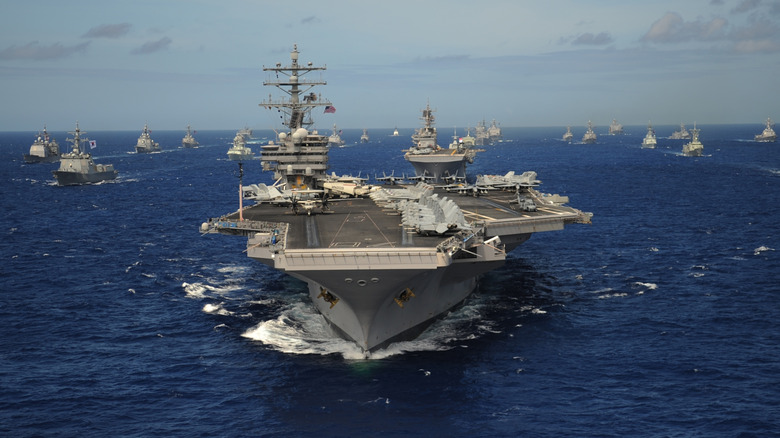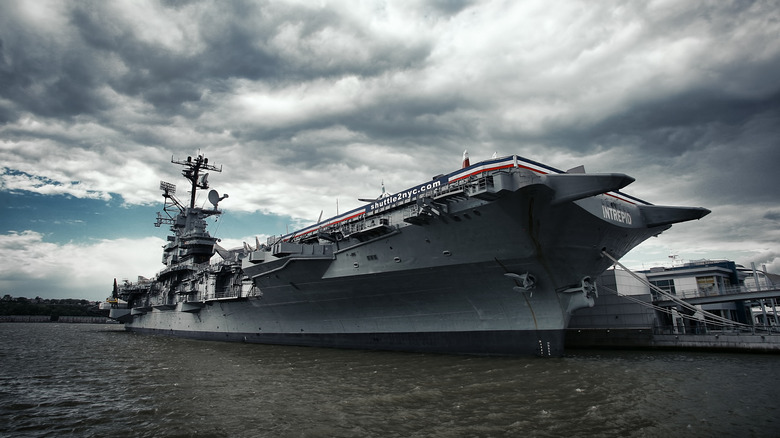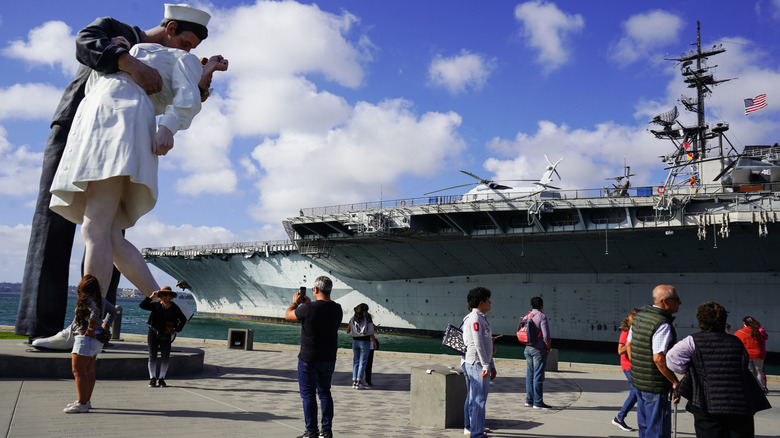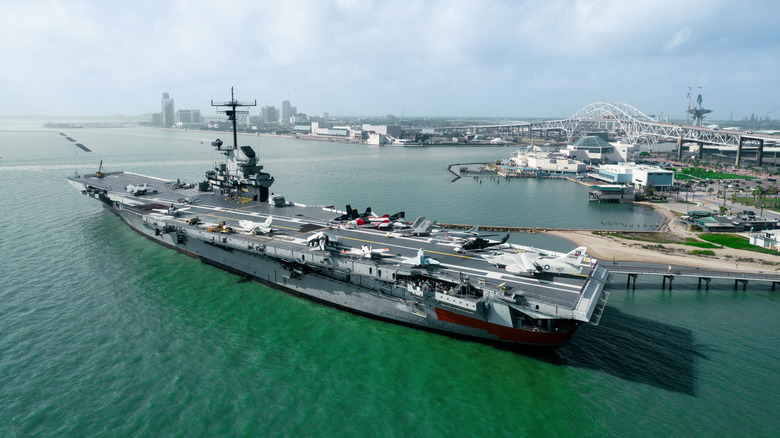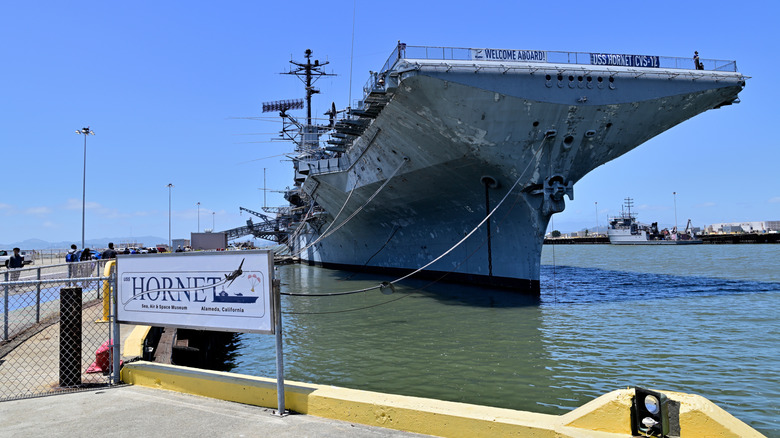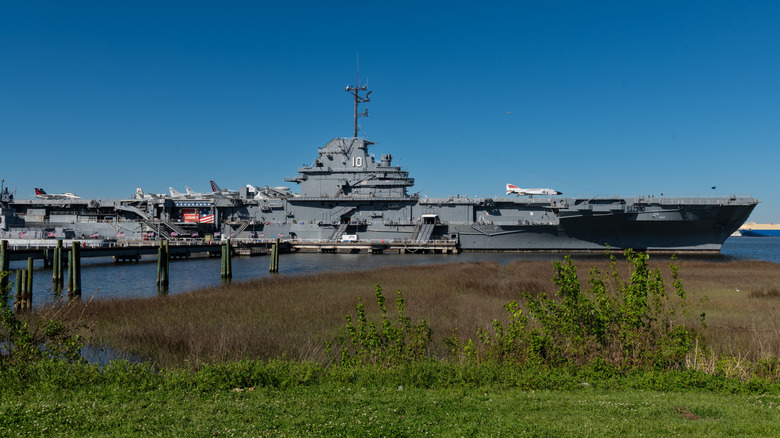5 US Aircraft Carriers You Can Visit As A Museum Ship
It's pretty mind-blowing that aircraft carriers even exist. Even more so, they were already a regular feature by the Second World War, almost a century ago. They're practically miniature floating cities, populated with massive crews, filled to the brim with fleets of aircraft, and (despite their size and scale) notoriously hard to sink. The U.S. Navy has 11 active aircraft carriers spread across the world on various missions. We could regale you all day long about interesting facts you probably didn't know about aircraft carriers, but there's no better way to experience these ships than seeing them for yourself in person. You don't need to join the Navy to do so. You can find one that's been converted into a museum ship.
Some of the oldest ships in active military service today include the USS Constitution, which was around when George Washington was alive. So age doesn't automatically consign a ship to the scrapyard, but eventually, it's time for a well-earned retirement. The U.S. Navy has a couple of options when it comes to decommissioned ships, one of which is converting them into a museum exhibit. The Navy has a lot of U.S. battleships you can visit. Here, we'll take a look at aircraft carriers specifically. Each of the following engineering marvels below lets you set foot on them and experience history with all five senses.
USS Intrepid -- New York City, New York
Just off Pier 86 in Manhattan, New York City, lies the USS Intrepid, a famous WWII-era aircraft carrier. The Intrepid began her storied military career in 1943, being sent to capture the Marshall Islands on the Pacific Front, then to Micronesia (via Naval History and Heritage Command). She was instrumental in a series of island-hopping raids until she took a torpedo hit that crippled her rudder. Defying belief, the crew created an ad-hoc sail to keep her aimed true as they headed back to California to repair and rearm. A few months later, she returned, dedicating a significant portion of her career to assisting in the Philippines' liberation from the Japanese Empire. She then continued to Japan itself, supporting further operations until the eventual surrender and occupation. She helped shoot down planes and sink battleships, and endured hits from kamikazes.
Following World War II, she went through several upgrades and recommissionings, serving in various missions and training capacities throughout the Cold War. At one point, she even helped pick up a returned astronaut. Most of her service after World War II involved no violent conflict, with the exception of her participation in the Vietnam War in 1966. After 31 years of service, the Navy formally set her aside in 1974. It was only thanks to community efforts that she was spared a permanent residence in the scrapyard — and became instead, as you already know, a long-term resident of Manhattan.
The Intrepid Museum comprises various permanent and temporary exhibitions. There are tons of events for children and adults, and the museum includes a submarine and several aircraft. Find more information here.
USS Midway -- San Diego, California
The Battle of Midway is not just one of the most important air battles in aviation's short history; It's one of the greatest battles in all of history, period. And it positioned the U.S. to win the Pacific Front. In addition to countless downed planes, five aircraft carriers were sunk in total. The USS Midway was not one of them, but rather a ship christened in remembrance of that brutal battle. In fact, the Midway was fully expected to aid the war effort. Only one problem: The war ended a mere week prior to its commissioning on September 10th, 1945, after a breakneck 17-month construction (via USS Midway Museum). So yes, ironically, the USS Midway never saw Midway or any World War II conflict.
Although it was too late for the Second World War, Midway served valiantly in various capacities and locations during the Cold War. Its orders took it to the Arctic, the coast of Western Europe, and later to Vietnam. She was pivotal during the Saigon evacuation effort in 1975. She later spent some time in Japan, took part in the Persian Gulf conflict, and helped with an evacuation after an eruption threatened the U.S. Clark Air Force Base in the Philippines. Her long career came to an end in 1992, and over a decade later, the USS Midway Museum opened to the public in 2004.
The USS Midway Museum offers a comprehensive experience. Aside from regular tours and interactive experiences, visitors can even spend a night on the ship to get a taste of living in such cramped quarters. They offer volunteer opportunities to keep the ship safe and in good condition. Buy tickets and plan your visit here.
USS Lexington -- Corpus Cristi, Texas
The USS Lexington is an aircraft carrier docked in Corpus Christi, Texas. You may have already unknowingly seen the Lexington, even if you've never set foot in the museum; It's one of the aircraft carriers used to film the movie "Pearl Harbor," although it played the USS Hornet, another ship on this list. Lexington was christened the USS Cabot while under construction prior to her maiden voyage in 1943, according to the USS Lexington Museum, but then the original USS Lexington unexpectedly sank. The Cabot thus became the reincarnation of the original Lexington.
Perhaps to avenge her namesake, Lexington became a thing to be feared on the Pacific Front for the rest of World War II. She spent nearly a year in combat, destroying hundreds of enemy planes, ships, and cargo, which were sent to the ocean floor. To the Japanese, she seemed unsinkable; they called her"The Blue Ghost," seeing her return after believing they'd properly condemned her to a watery grave on four separate occasions. Her post-World War II service saw her around the world. In one instance, she waited as backup during the Laotian Crisis in 1959, and in another, she helped blockade Cuba when one of the most historically significant submarines in military history nearly set off World War III. Her service formally ended in 1991, and her stint as a museum ship started the very next year.
We have the USS Lexington museum thanks to a local community joining hands to keep it maintained and running. The USS Lexington Museum takes pride in never accepting a cent from the government to stay in operation. The museum includes a theater, flight simulators, and model collections. Find more information to plan your own visit here.
USS Hornet -- Alameda, California
There are multiple ships named Hornet, so we mustn't get them confused. During World War II, there were two aircraft carriers: the USS Hornet (CV-8) and the USS Hornet (CV-12). According to the Naval History and Heritage Command, the first (CV-8) was the staging ground for the famous Doolittle Raid that sent bombers deep into Japan to hit essential targets. She lent her efforts in the Battle of Midway, and to the island-hopping campaigns in the Solomon Islands and the bloody Guadalcanal offensive. Mortal wounds received in the Battle of the Santa Cruz Islands made her the aircraft carrier with the shortest service life, and she plunged to the ocean's depths only to be rediscovered in 2019.
Aficionados of naval history can visit the surviving CV-12, constructed in 1943 (via USS Hornet Museum). Though she didn't show up on the war front until 1944, she made herself useful. This USS Hornet took part in air raids and amphibious assaults across islands and seas, including New Guinea, Guam, the Philippine Sea, and Okinawa. Following World War II and some overhauls and recommissionings, she helped with the war effort in Vietnam in 1967. Her final decommissioning was in 1970, and by 1989, she became a museum ship.
On board the Hornet, you'll see a smattering of exhibits, including several planes, one of which is the F/A-18C Hornet jet. The Hornet fighter only came onto the scene in 1984, after the USS Hornet's decommissioning, but we'd bet one reason it's on exhibit is its shared name. If ghost ships are your thing, the USS Hornet also claims a few nighttime paranormal experiences. Find tickets and more information here.
USS Yorktown -- Mount Pleasant, South Carolina
The USS Yorktown is yet another aircraft carrier on this list named after a previous incarnation sunk during World War II. That was the USS Yorktown (CV-5). Built in 1937, she was involved in the fight against Imperial Japan from the very beginning. She joined submarine hunting and island-hopping operations, but it all came to a close in 1942, when she went down guns blazing after an epic struggle during the Battle of Midway. Interestingly, it was the same man who rediscovered the Titanic (Robert Ballard) who found the lost USS Yorktown in 1998. The surviving USS Yorktown (CV-10) was named after her predecessor.
Like many ships during this period, her builders rushed her out in record time to keep pressure on the Pacific Front. One of her roles included fighting in the infamous battle of Iwo Jima. Perhaps her greatest achievement was sending the Japanese Empire's Yamato, the biggest battleship Japan had at the time, to the ocean floor. Navy men called her "Fighting Lady." Following the war, like most ships, she got recommissioned and overhauled to meet changing needs. Extra feathers in her cap include 3 years in Vietnam and being the welcome-home party for the astronauts fresh out of re-entry on the Apollo 8 (via Patriots Point).
The USS Yorktown is one of several permanent features at Patriots Point in Mount Pleasant, which includes the USS Laffey, Apollo 8 capsule, the Medal of Honor Museum, and the Ship Library. Ghost tours are a popular after-hours experience. Like other ships, they offer an overnight stay where you enjoy the same claustrophobic living conditions as a Navy sailor. Find tickets and more information here.
